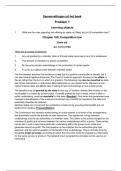2020-2021
Lecture 1
Treaty on European Economic Community – 1957
- It created the EEC and institutions
- Decision in the Council – Unanimity (All have to agree) or Qualified
Majority Voting (There needs to be a majority 55% of ministers needs to
be in favor 15 countries out of 27. It needs to represent at least 65% of
the population of the EU.) It leads to supranationalism, your sovereignty
gets taken away.
- Created a common costumes tariff, a common agriculture, transport and
competition policy.
Single European Act – 1986 (Created in Luxemburg)
- There was a shift towards qualified majority voting rather than unanimity.
– More supranationality because small countries can be outvoted.
- New policies were introduced
- Introduction of the Court of First Instance (the general court). It was
created to deal with the increasing number of cases to Luxemburg, it also
led to the need for more judges. Deals with cases brought by individuals
(companies).
- 31st December 1992 – Deadline for the creation of a single market
Treaty of the European Union (Treaty of Maastricht) – 1992
- Europe wanted to be more than an economic community, but also social
and political community.
- Created a three pillar structure: 1) EC 2) Foreign Policy and Security 30
Justice and Home Affairs.
- Creation of new policies such as culture, public health, consumer
protection.
- Introduction of a co-decision for the European Parliament as a decision-
making instrument.
- Institutions such as European Central Bank and Committee of regions were
introduced.
Treaty of Amsterdam – 1997
- Recognition that EU is based on respect and fundamental rights,
democracy and rule of law.
1
, - More power to the European Parliament, co-decision expanded.
- Asylum was incorporated in the EC pillar, meaning that it would get
supranational status. Asylum became a EU issue.
Treaty of Lisbon – 2007
- Creation of a high representative for foreign and security policy and a
president of the European council.
- Increased role of national parliaments.
- Three pillars were abolished
- EC treaty becomes treaty on the functioning of the EU (TFEU)
Role of the EP became more powerful, it moved from consultant
to a co-decider.
More qualified majority voting . It became more supranational.
More worries with the democratic deficit. National Parliaments
are more involved.
Legislative Framework of the European Union
Primary Legislation:
- Treaties on the European Union
- Treaty on the Functioning of the EU
- Fundamental Rights Charter
Secondary Legislation (Always based on primary legislation):
- Regulations
- Directives - This is in the book, no need to memorize
- Decisions
Seminar 1 Exercises - How to work with the Treaty Texts
Exercise 1
Which Treaties are in your Basic Treaties Book?
Treaty of The European Union
Treaty on the Functioning of the EU
Charter of Fundamental Human Rights of the EU
Treaty of Lisbon
2
,Exercise 2
Browse through the Treaty on the Functioning of the EU (TFEU). What is the
correct order in
the TFEU? From big to small.
A part, title, article, chapter
B part, title, chapter, paragraph, article
C part, title, chapter, article, paragraph- X
Exercise 3
Turn to page 32. Article 38 TFEU shows between brackets (ex Article TEC). What
does the number between brackets mean?
Old article from the Treaty of the European Community
Exercise 4
Carlos is a Spanish national, who lives in Scheveningen. He would like to stand as
a candidate for the local party ‘Politieke Partij Scheveningen’ during the Local
Council Elections. The chair of the party informed Carlos, that unfortunately he
could not put Carlos name on the candidate’s list because he does not have the
Dutch nationality. Is the assumption of the Chair correct? Please motivate your
answer based on the TFEU.
He is wrong. Under Article 22 Paragraph 1, it is stated that citizens of
the EU that reside in a member state he is ot a national shall have the
right to vote and stand as a candidate at municipal elections in the
member states he resides in.
Exercise 5
Miss Theroux, a French national, who works for ‘France Telecom’ as a
telecommunications specialist. After some thorough investigations she discovers
that her salary and that of her other female colleagues is some 10% lower than
that of the male co-workers doing the same work. Miss Theroux has some
knowledge of EU law and is convinced this is violating basic rules. Give Miss
Theroux your advice in this case, based on the TFEU.
Under article 157 paragraph 1 it states that male and female workers
should be paid the same value for the same work. Miss Theroux should
speak with her employee and if that does not work, Miss Theroux
should take legal action by going to her national court.
3
,Exercise 6
Where in the TFEU can you find the article that allows the European Commission
to propose
environmental legislation (the legal basis for environmental legislation)?
Under article 191 and 192 TFEU
Exercise 7
Where in the TFEU can you find the Treaty article on the ordinary legislative
decision
making procedure?
On Article 289 TFEU
Exercise 8
Where in the TEU and TFEU can you find the articles that list the powers and
tasks of the
Court of Justice of the European Union?
In Article 19 Paragraph 3 TEU and Article 251 TFEU
Exercise 9
Please read art 101 TFEU. A large Dutch firm together with an Italian and
German company
in construction materials decides to fix their selling prices for concrete. Is this
allowed under
European Union law?
No
4
, Lecture 2
Supremacy - Very important
Costa/ E.N.E.L. Case (C-6/64) – Italian citizen who owned shares in electricity
company, however, the electricity sector was nationalized. In protest, Mr. Costa
refused to pay his bills. The company them proceeded to sure Mr. Costa for not
paying his bills. He then claimed that the nationalisation of the company violates
the treaty of Rome, community law.
What to do when EU law and national law contradict? If they contradict, the EU
must always take precedent, it must be supreme. Interpretation must be
uniform, otherwise what’s the purpose of EU law? EU also takes precedent even
if a national legislation exists or whether it still needs to pass.
Direct Effect - Very important
Van Gen den Loos Case (C-26/62) – Transport company that imported chemicals
from West Germany to the Netherlands. On import, the Dutch charged a tariff for
that import. The company objected because that tariff is contrary to EU
community law. Article 12 of TOR (Article 30. TFEU). Member states cannot
introduce new tariffs on imports and exports. Established that EU law created
rights and obligations for individuals and that those rights and obligations can be
enforced in national courts under three criteria. The legal provision must be:
1- Clear and Precise
2- Unconditional
3- Not subject to any further implementing measures
Vertical Direct Effect
Vertical relationship between the member state and an individual (legal person
or natural person). EU laws provides us with rights and obligations, these can be
enforced by the national court. If a member state disregards those rights, we can
enforce those rights in national court. Member states need to enforce those laws.
TFEU articles with direct effect:
“Those provisions that impose a clear, precise and unconditional
obligation upon MS”
- Free movement of goods Art. 34 TFEU
- Free movement of persons Art. 45 TFEU
- Free movement of services Art. 56 TFEU
- Freedom of establishment Art. 49 TFEU
- Non discrimination Art. 2 TFEU jo art. 18 TFEU
- Equal Treatment Art. 157 TFEU
- Competition Law Art. 101 TFEU jo art. 102 TFEU
Direct Affect and Secondary Legislation:
- Regulations – Yes, if the regulation creates rights/obligations for
individuals.
5





